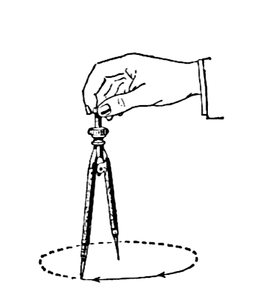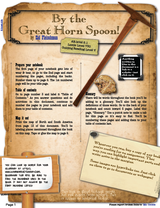|
The earth is warmest along the equator, rather than the North or South Poles, because the sun is strongest here (check out this cool site to see why). Warm air is lighter than cold air, so the warm air along the equator rises up into the atmosphere. This is called a low pressure system. Cold air over the poles then moves toward the equator to fill in the space as the warm air rises. This is called a high pressure system. If the earth weren't spinning, the wind would just blow from high to low pressure areas, but the earth is also spinning. This creates what is known as the Coriolis effect. The Coriolis effect causes the wind to curve as it blows. You can try this simple experiment to see the Coriolis effect for yourself.
How are your lines different? Your first line represents what wind would do without the Coriolis effect. Your second line represents what happens when wind blows from the North Pole toward the equator with the Coriolis effect caused by the rotation of the earth. Because of the earth's rotation and the Coriolis effect, wind in the northern hemisphere moves in a counterclockwise motion while wind in the southern hemisphere moves in a clockwise motion. The Coriolis effect is named for the French scientist Gaspard-Gustave de Coriolis even though he wasn't the first to recognize it. This lesson was adapted from NASA's Earth Science Enterprise lesson "Blow, Wind, Blow!" that is no longer published. "“Blow, Wind, Blow!” El Niño Making Sense of Weather." Earth Science Enterprise. National Aeronautics and Space Administration, 22 Jan. 2003. Web. 20 Dec. 2010. <http://kids.earth.nasa.gov/archive/nino/global.html>. Bunglesmate. "How to Find the Center of a Circle." Instructable.com. Autodesk, Inc., 2008. Web. 8 Jan. 2016. <http://www.instructables.com/id/How-to-find-the-center-of-a-circle/>. Dunbar, Brian. "What Is the Coriolis Effect?" NASA. NASA, 10 Apr. 2008. Web. 26 Apr. 2015. <http://www.nasa.gov/audience/forstudents/brainbites/nonflash /bb_home_corioliseffect.html>. McKissick, Katie. "What Is the Coriolis Effect?" SciJinks. NOAA and NASA, n.d. Web. 27 Sept. 2015. <http://scijinks.jpl.nasa.gov/coriolis/>. O'Connor, J J, and E. F. Robertson. "Gaspard Gustave De Coriolis." The MacTutor History of Mathematics Archive. School of Mathematics and Statistics University of St Andrews, Scotland, July 2000. Web. 26 Apr. 2015. Pearson Scott Foresman. Compass3. Digital image. Wikimedia Commons. Wikimedia Foundation, 15 Dec. 2007. Web. 26 Apr. 2015. "Seasons and Ecliptic Simulator." University of Nebraska-Lincoln. Nebraska Astronomy Applet Project/National Science Foundation, 19 Mar. 2009. Web. 8 Jan. 2016. <http://astro.unl.edu/naap/motion1/animations/seasons_ecliptic.swf>. "What Is the Coriolis Effect?" ESchool Today. ESchool Today, 2010. Web. 26 Apr. 2015. <http://www.eschooltoday.com/winds/the-coriolis-effect.html>.
Comments are closed.
|
Author
I often struggle to find websites with thorough explanations in simple language to help kids understand historical events or scientific concepts, so I decided to create some of my own! -Cookie Davis
Archives
March 2024
|


 RSS Feed
RSS Feed